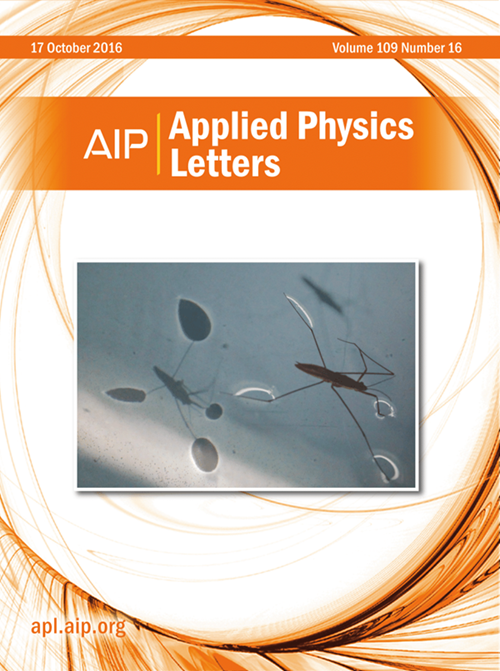微尖端操纵折纸的坚固扭曲少层石墨烯
IF 3.5
2区 物理与天体物理
Q2 PHYSICS, APPLIED
引用次数: 0
摘要
扭曲少层石墨烯(tFLG)已成为研究新型强相关和拓扑现象的理想模型系统。然而,具有高结构稳定性的 tFLG 的实验构建仍具有挑战性。在这里,我们介绍了一种通过聚合物微尖操纵折纸来制造坚固的 tFLG 的高易用性方法。通过使用自行制备的聚合物微尖(由多个二甲基聚硅氧烷、聚氯乙烯和石墨片组成)折叠石墨烯层,我们制备出了不同扭曲角度(0°-30°)和不同层数的 tFLG,包括扭曲双层(1 + 1)、扭曲双层(2 + 2)、扭曲双三层(3 + 3)和更厚的层数。甚至还创造出了 ABC 叠层的 tFLG,如在 ABC-ABA 域壁区域共存的 ABC/ABC 和 ABC/ABA 扭曲石墨烯。我们发现,折纸制造的 tFLG 对热和机械扰动(包括加热和转移)具有很高的稳定性,这可能归功于其特殊的折叠和撕裂结构。此外,基于丰富的样品类型,我们揭示了 tFLG 与扭转角度和堆叠阶数相关的拉曼特性,这对于理解堆叠调制声子光谱非常有价值。我们的实验为构建结构坚固的 tFLG 提供了一种简单高效的方法,为研究高度稳定的扭曲范德华异质结构铺平了道路。本文章由计算机程序翻译,如有差异,请以英文原文为准。
Micro-tip manipulated origami for robust twisted few-layer graphene
Twisted few-layer graphene (tFLG) has emerged as an ideal model system for investigating novel strongly correlated and topological phenomena. However, the experimental construction of tFLG with high structural stability is still challenging. Here, we introduce a highly accessible method for fabricating robust tFLG by polymer micro-tip manipulated origami. Through using a self-prepared polymer micro-tip—which is composed of multiple dimethylpolysiloxane, poly(vinyl chloride), and graphite sheets—to fold graphene layers, we fabricated tFLG with different twist angles (0°–30°) and various layers, including twisted bilayers (1 + 1), twisted double-bilayers (2 + 2), twisted double-trilayers (3 + 3), and thicker layers. Even ABC-stacked tFLG were created, such as twisted ABC/ABC and ABC/ABA graphene coexisting in an ABC-ABA domain wall region. We found that the origami-fabricated tFLG exhibits high stability against thermal and mechanical perturbations including heating and transferring, which could be attributed to its special folding and tearing structures. Moreover, based on the rich types of samples, we revealed twist-angle- and stacking-order-dependent Raman characteristics of tFLG, which are valuable for understanding stacking-modulated phonon spectroscopy. Our experiments provide a simple and efficient approach to construct structurally robust tFLG, paving the way for the study of highly stable twisted van der Waals heterostructures.
求助全文
通过发布文献求助,成功后即可免费获取论文全文。
去求助
来源期刊

Applied Physics Letters
物理-物理:应用
CiteScore
6.40
自引率
10.00%
发文量
1821
审稿时长
1.6 months
期刊介绍:
Applied Physics Letters (APL) features concise, up-to-date reports on significant new findings in applied physics. Emphasizing rapid dissemination of key data and new physical insights, APL offers prompt publication of new experimental and theoretical papers reporting applications of physics phenomena to all branches of science, engineering, and modern technology.
In addition to regular articles, the journal also publishes invited Fast Track, Perspectives, and in-depth Editorials which report on cutting-edge areas in applied physics.
APL Perspectives are forward-looking invited letters which highlight recent developments or discoveries. Emphasis is placed on very recent developments, potentially disruptive technologies, open questions and possible solutions. They also include a mini-roadmap detailing where the community should direct efforts in order for the phenomena to be viable for application and the challenges associated with meeting that performance threshold. Perspectives are characterized by personal viewpoints and opinions of recognized experts in the field.
Fast Track articles are invited original research articles that report results that are particularly novel and important or provide a significant advancement in an emerging field. Because of the urgency and scientific importance of the work, the peer review process is accelerated. If, during the review process, it becomes apparent that the paper does not meet the Fast Track criterion, it is returned to a normal track.
 求助内容:
求助内容: 应助结果提醒方式:
应助结果提醒方式:


